

Electronic Journal of Probability (EJP) and Electronic Communications in Probability (ECP) are electronic journals free for authors and free for readers. Created in 1995, they are sponsored by the Bernoulli Society and the Institute of Mathematical Statistics (IMS) who publishes several other journals such as the Annals of Probability (AoP) and the Annals of Applied Probability (AoAP).
Up to now, the administrative and technical tasks of managing editor and production editor are supported by a university professor, reducing the direct cost of the journal. This scheme is not sustainable due to the success of EJP-ECP : see the graphics below. Also starting from January 2016, the journals will be handled by Mattson Publishing Services (MPS) and VTEX, just like AoP and AoAP. Technically, this new organization for EJP-ECP implies that the editorial software Open Journals Software (OJS) will be replaced by the Electronic Journal Management System (EJMS) developed by VTEX, while the diffusion and archival will be handled by Project Euclid, just like for AoP and AoAP. In contrast with AoP and AoAP, EJP and ECP will stay purely electronic and free for authors and for readers. This will cost about $30K per year to the IMS, and it is expected that at most 30% will be covered by publication charges contributed by authors via the Open Access Fund. In fact EJP-ECP will follow exactly the workflow used by the IMS for Electronic Journal of Statistics.
Note that MPS is a small US company specialized in open access publications, while VTEX is a small Lithuanian company specialized in typesetting and editorial hosting. Both companies are handling most of the IMS journals. Note also that Lithuania belongs to the Euro zone.
In France, the Centre de diffusion des revues académiques mathématiques (CEDRAM) plays a role similar to the one of the IMS, for some French based journals such as Annales de l'Institut Fourier (AIF). Presently the CEDRAM is willing to deploy OJS, and to handle typesetting internally.



Personally, I have served as a Managing and Production Editor for EJP+ECP mainly from 2012 to 2015 inclusive. In particular, I had to process (format check and metadata) 341+467 = 808 accepted papers (about 3544 + 12556 = 16100 pages). This support mission consisted also in solving all the technical issues with the editors, the reviewers, and the authors. Among other tasks, I also wrote a bunch of Bash / Python / LaTeX files to produce statistics, monitoring, and style. I was also involved in the 2012 database transition to OJS 2.x and in the 2015 transition from OJS to EJMS. All in all, it was for me a fantastic experience, during which I have learned many things about the internals of publishing.
For French readers. On m'a souvent reproché de passer du temps sur EJP/ECP alors que je n'étais pas payé pour ça. Ces reproches sont venus aussi bien d'acteurs de l'édition que de certains collègues ! Pourtant, la lourde tâche qui était la mienne ne faisait pas plus partie de mes attributions théoriques que toutes sortes d'autres corvées que les scientifiques universitaires doivent affronter : administration, copies, surveillances, etc. Ma conviction, après cette expérience, est qu'il est tout à fait acceptable qu'un scientifique joue le rôle de l'homme à tout faire temporairement d'une revue qui démarre ou qui est en difficulté, ou durablement d'une revue qui publie peu comme le journal de l'École Polytechnique. Cela étant dit, lorsque le volume de publication est au niveau atteint par EJP/ECP, ceci n'est pas durable et il est évidemment préférable que ce travail technique et de gestion éditoriale soit accompli à terme par des professionnels mutualisés dont c'est le métier. C'est en cela que la décision de l'IMS ou le projet du CEDRAM sont particulièrement pertinents. La solution retenue par l'IMS pour EJP-ECP est à la fois généreuse et cohérente avec sa logique de fonctionnement. OJS est un très bon produit, qui a contribué au succès de EJP-ECP pendant près de dix ans. Je reste disponible pour aider à améliorer la situation des revues françaises, et les faire évoluer si possible vers un modèle qui les rendrait libres d'accès pour les auteurs et les lecteurs. Le reste est, de mon point de vue, plus de l'ordre des moyens que de la fin.